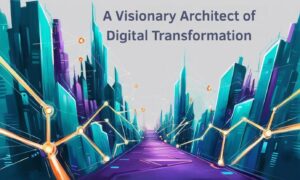Digital transformation is the integration of digital technology into all areas of a business, fundamentally changing how you operate and deliver value to customers. It’s also a cultural change that requires organizations to continually challenge the status quo, experiment, and get comfortable with failure.
Digital transformation is imperative for all businesses, from the small to the enterprise. That message comes through loud and clear from seemingly every keynote, panel discussion, article, or study related to how businesses can remain competitive and relevant as the world becomes increasingly digital. What’s not clear to many business leaders is what digital transformation means. Is it just a catchy way to say moving to the cloud? It’s also worth noting that today’s organizations are in different places on the road to digital transformation. If you are feeling stuck in your digital transformation work, you are not alone. One of the hardest questions in digital transformation is how to get over the initial humps from vision to execution. It creates angst: Many CIOs and organizations think they lag far behind their peers on transformation, when that isn’t the case.
Digitization has become one of the most important economic themes of the future, affecting not only the economy, but society as a whole. Due to the ever-changing economic environment and changing digitization processes, organizations can face a major challenge. Digitization can be defined as the conversion of signals and media objects (e.g. documents, images or sounds) into digital form that are processed, stored and transmitted via digital devices and networks due to the adoption of digital technologies and the use of systems built on them. Regarding digitalization, there are different levels of intensity: mere presentation and information (website), sales channel functions (e-commerce) and integration of business processes (e-commerce) into new business models with virtual products or services.
Get PDF Brochure With Latest Innovations at:
https://www.transparencymarketresearch.com/sample/sample.php?flag=B&rep_id=56367
Impact of Covid 19
This year, the COVID-19 pandemic has brought new urgency to meeting digital transformation goals – and forced many organizations to speed up transformation work. Yet IT leaders continue to grapple with challenges including budgeting, talent struggles, and culture change. Because digital transformation will look different for every company, it can be hard to pinpoint a definition that applies to all. However, in general terms, we define digital transformation as the integration of digital technology into all areas of a business resulting in fundamental changes to how businesses operate and how they deliver value to customers. Beyond that, it’s a cultural change that requires organizations to continually challenge the status quo, experiment often, and get comfortable with failure. This sometimes means walking away from long-standing business processes that companies were built upon in favor of relatively new practices that are still being defined. A business may take on digital transformation for several reasons. But by far, the most likely reason is that they have to: It’s a survival issue. In the wake of the pandemic, an organization’s ability to adapt quickly to supply chain disruptions, time to market pressures, and rapidly changing customer expectations has become critical. And spending priorities reflect this reality.
At a recent MIT Sloan CIO Symposium series event, IT leaders agreed that consumer behavior has quickly shifted in many ways since the start of the pandemic. Sandy Pentland, a professor at the MIT Media Lab, described how optimized automated systems in areas like supply chain management broke down when faced with rapid shifts in both demand and supply — a reality that just about everyone has faced on a personal level during the pandemic.
How Digital Transformation Shaping Businesses?
One example of digital transformation is the use of cloud computing. This reduces reliance on user-owned hardware and increases reliance on subscription-based cloud services. Some of these digital solutions enhance capabilities of traditional software products (e.g. Microsoft Office compared to Office 365) while others are entirely cloud based (e.g. Google Docs). As the companies providing the services are guaranteed of regular (usually monthly) recurring revenue from subscriptions, they are able to finance ongoing development with reduced risk (historically most software companies derived the majority of their revenue from users upgrading, and had to invest upfront in developing sufficient new features and benefits to encourage users to upgrade), and delivering more frequent updates often using forms of agile software development internally. This subscription model also reduces software piracy, which is a major benefit to the vendor.
With the introduction of the World Wide Web, the scope, dimension, scale, speed and effects of digitization fundamentally changed, resulting in increased pressure on the societal transformation process. Companies including Dell were quick to take advantage of the World Wide Web around 1996–1997, disrupting traditional PC manufacturing companies like IBM by selling direct to consumers rather than through dealer networks or hobby shops, and gaining valuable insights into consumer behaviour as they navigated the website.
Thus, the debate surrounding digitization gained increased practical importance for politics, business and social issues, and is linked to political work issues for community development, new changes in practical business approaches, effective opportunities for organizations in operational and business process development, with effect on internal and external efficiency of IT to name a few. In 2018, digital transformation in manufacturing was slated to generate over a massive global value during the next few years.



































